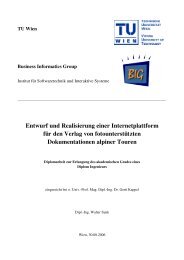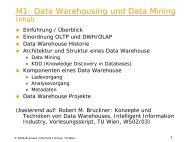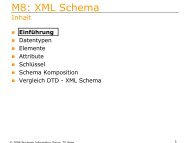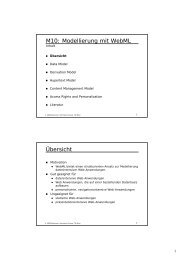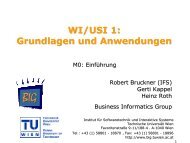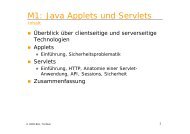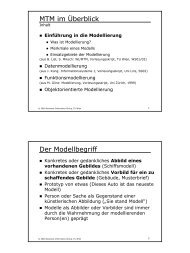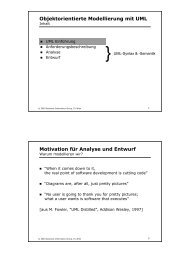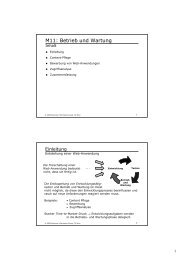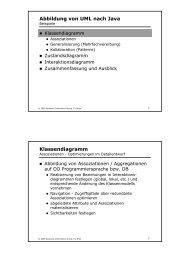Ph.D. Thesis - Business Informatics Group
Ph.D. Thesis - Business Informatics Group
Ph.D. Thesis - Business Informatics Group
You also want an ePaper? Increase the reach of your titles
YUMPU automatically turns print PDFs into web optimized ePapers that Google loves.
Chapter 1 Introduction<br />
In order to discuss communalities as well as differences between data exchange in the<br />
data engineering field and model exchange in the model engineering field, an alignment of<br />
the meta-modeling layers of both fields seems to be beneficial. Figure 2 shows this alignment<br />
by using the 4-layer meta-modeling architecture proposed by the OMG [OMG05e].<br />
On the layer M0 concrete objects reside which represent "real world" entities. Layer M1 determines<br />
which objects shall be created for the domain of interest, described in a so-called<br />
domain model. On layer M2, all concepts needed for describing domain models are defined,<br />
so to say the language for describing domain models. In order to define the language specification<br />
on M2 requires another meta-layer, i.e. layer M3, that covers meta-concepts necessary<br />
for creating one’s own language, so to say it represents the meta-language. Normally,<br />
as meta-language, a language is chosen which is able to describe itself, in order to ensure<br />
that the M3 layer is self-contained.<br />
M3<br />
M2<br />
M1<br />
M0<br />
Relational<br />
DataModel<br />
aRelational<br />
Model<br />
Data Engineering Model Engineering<br />
No explicit formalism<br />
XML<br />
Schema<br />
DataModel<br />
anXMLSchema<br />
Model<br />
UML<br />
aUML<br />
Model<br />
o1 o1 o1<br />
MOF<br />
SysML<br />
aSysML<br />
Model<br />
o1<br />
Legend<br />
Correspondence<br />
Transformation<br />
Instance-Of<br />
Figure 1.1: Meta-layers of Data Engineering and Model Engineering in Comparison<br />
In the area of data engineering, integration scenarios concerning the layers M0 to M2 have<br />
been considered, but no scenarios concerning the M3 layer have been investigated, because<br />
in most cases no explicit meta-language has been applied to define the used data models 3 .<br />
Furthermore, no user-defined data models are employed as is the case in model driven engineering<br />
with user-defined modeling languages which gain more and more importance<br />
through the trend to domain-specific languages (DSL) [Fow05]. In model engineering, the<br />
integration scenarios are "lifted" one layer upwards, i.e., layer M1 to M3 are primarily concerned.<br />
Nevertheless, similar problems occur when two modeling languages are integrated<br />
on the M2 layer as when two schemas are integrated on the M1 layer. In particular, the<br />
notion of heterogeneity as main driver for integration problems has been established in the<br />
3 The main reason for this circumstance is that the relational data model and the XML schema data model represent<br />
4<br />
reflexive languages, i.e., they can be described in their own terms.



